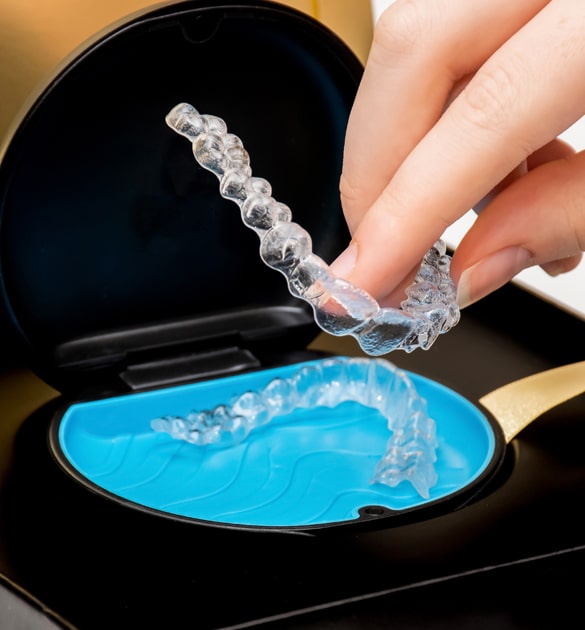
Invisalign is a popular orthodontic treatment option for kids and teens who want a more discreet and comfortable way to straighten their teeth. Unlike traditional metal braces, Invisalign aligners are clear, removable, and require a higher level of responsibility. If your child has recently started Invisalign or is about to begin treatment, your support can make all the difference. As a parent, there are specific steps you can take to ensure your child follows through with their treatment and achieves the best results possible.
Understanding How Invisalign Works
Invisalign uses a series of custom-made aligners that gradually move teeth into their proper positions. Your child will wear each set of aligners for about one to two weeks before switching to the next. These aligners must be worn at least 20 to 22 hours a day to be effective.
Because the aligners are removable, your child will need to take them out to eat, drink anything other than water, and brush and floss. The flexibility is a major benefit, but it also means that it’s easier to forget or delay putting the aligners back in.
Set Clear Expectations From the Start
Before treatment begins, sit down with your child and talk about what Invisalign will require. Explain that even though the aligners are removable, wearing them consistently is crucial. Let them know that skipping hours or leaving them out too often can slow progress or lead to results that fall short of the goal.
Setting expectations early helps your child take ownership of the process. Encourage them to view Invisalign as something they are doing for themselves—not just something being done to them.
Establish a Daily Routine
Help your child build a habit around wearing and caring for their aligners. Encourage them to put the aligners back in immediately after meals or snacks. A visual reminder like a note on the fridge or an alarm on their phone can be helpful, especially in the early stages.
Some families find success by tying Invisalign care to other daily activities. For example, your child can clean their aligners while brushing their teeth in the morning and at night. Keeping the aligners in a designated spot when not in use also helps prevent misplacement.
Emphasize the Importance of Oral Hygiene
Good dental hygiene is always important, but it becomes even more essential during Invisalign treatment. If your child doesn’t brush after eating, food particles can get trapped between their teeth and the aligners, increasing the risk of cavities or bad breath.
Make sure your child brushes their teeth after every meal and snack. If that’s not possible—for example, at school—have them rinse their mouth with water before putting the aligners back in. A travel toothbrush and small tube of toothpaste in their backpack can make things easier when they’re not at home.
Monitor Their Progress Without Hovering
It’s natural to want to make sure your child is following the treatment plan, but try not to hover. Instead, check in regularly in a low-pressure way. Ask if they’ve had any trouble wearing the aligners or if they’ve noticed any discomfort.
You can also remind them to switch to the next aligner set when it’s time. Most orthodontists will give you a schedule to follow, or the aligners may be numbered to keep track. Make a note of these dates on a calendar or in a shared digital planner.
Encourage Responsibility and Independence
One of the benefits of Invisalign is that it gives kids the chance to take more responsibility for their own care. Trust your child to manage the aligners themselves, but be available for help and encouragement when needed.
If they lose a set of aligners, contact the orthodontist promptly to get a replacement or find out what the next steps should be. Mistakes happen, and how you respond can either reinforce a learning moment or create stress. Keep the focus on getting back on track.
Celebrate Milestones and Progress
Orthodontic treatment can take months or even years. Keeping your child motivated throughout the process is important. Celebrate small milestones like moving on to a new aligner set or hitting the halfway mark.
You don’t need to offer big rewards—just acknowledge their effort and progress. A few encouraging words, a favorite meal, or a fun family activity can go a long way in reinforcing positive habits.
Stay in Touch With the Orthodontist
Your child will have regular check-ins with their orthodontist to make sure everything is progressing as planned. Attend these appointments with them when possible. It’s a good time to ask questions and bring up any concerns your child may have mentioned at home.
Some orthodontists also offer virtual check-ins, especially for Invisalign patients. Staying connected and informed helps you stay involved without being overbearing.
Address Discomfort Early
Although Invisalign is generally more comfortable than traditional braces, some mild discomfort is normal when starting a new set of aligners. Let your child know this is part of the process and usually goes away in a day or two.
If the discomfort becomes more than mild or if something feels off, call the orthodontist. Addressing small issues early can prevent bigger problems down the road.
Be Patient and Supportive
Lastly, be patient. Your child is adjusting to something new that requires attention and effort. They may forget to wear the aligners at times or struggle with motivation. Rather than scolding, guide them back on track with support.
Invisalign is a commitment, but it’s also an opportunity for your child to gain confidence and take pride in their smile. With your involvement, they can build good habits that lead to a successful outcome.
Conclusion
Helping your child succeed with Invisalign isn’t about doing everything for them—it’s about setting them up with the tools, habits, and encouragement they need to stay consistent. With the right balance of structure and independence, your child will be well on their way to achieving the smile they’ve been hoping for.